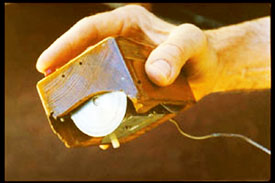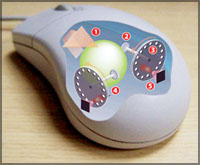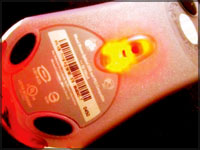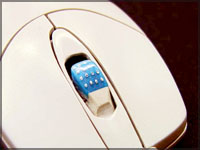|
Sonic's Desktop
The computer mouse
The silent rodent of the computer world
 In
our last edition, we broke up the hardware components of the total
computer system as input devices, output devices, system unit and
secondary storage. Therefore, in today's edition, and in the future
editions, let's go into details of these divisions. In
our last edition, we broke up the hardware components of the total
computer system as input devices, output devices, system unit and
secondary storage. Therefore, in today's edition, and in the future
editions, let's go into details of these divisions.
By now, you will be aware that it is through input devices that we
feed in any relevant data to the computer. With the development of
multimedia, now there is a host of various input devices. For a start,
let us explore the key input device which is the mouse. Sonic will
present you some important facts about this small device.
Evolution
|

The first computer mouse |
The mouse came into existence as a result of the need for a pointing
device which would enable easy navigation in the Graphical User
Interface provided by new operating systems.
This was invented by Douglas Engelbart of the Stanford Research
Institute in 1964. It used two wheels which are perpendicular(at 90
degrees) to each other, and the position of the cursor (the arrow in the
desktop) was determined by how far one wheel has gone in one direction
and how far the other wheel has moved in the perpendicular direction.
Thereafter, it evolved rapidly as explained hereafter.
Different types and how they work
* Mechanical mice
These detect movement by inspecting the movement in parts of the
mouse. The first mouse itself was a mechanical mouse since it detected
the motion of two wheels.
Thereafter, it was improved by replacing the two wheels with a ball
and the movement of the cursor was determined by checking the beams of
light coming through the chopper wheels (wheels with holes around the
edge) which were in contact with the ball.
The same was further improved by using two rollers to be in contact
with the ball. These too had chopper
|

How the ball mouse
works |
wheels at the ends of the rollers and the position of the
cursor was determined by checking the rotation of these rollers where
each was mapped to a movement along the X and Y axes respectively. This
is the ball mouse that you often see in your computers nowadays.
* Optical mice
Optical mice detect movement of the mouse by inspecting the surface
which the mouse is moved on.
These came into being in the 1980s and there were two ways by which
the movement of the mouse was detected. In one method, an infra-red LED
was used along with an infra-red sensor and the movement was determined
by inspecting the grid lines that were marked on the surface on which
the mouse was moved.
This method required a special mouse pad with gridlines. In the other
method, a visible-light image sensor tracked the motion of light dots in
a dark field of a printed paper or similar mouse pad.
As technology developed, the optical mouse was improved by using
optoelectronic sensors, which determine the motion by taking images of
the surface at a fast rate and analysing them using the image processing
chips in the mouse.
|

An optical mouse |
The difference in successive pictures are mapped on to a movement
along X and Y axes. This approach doesn't require a special mouse pad as
primitive optical mice. These mice are really handy since the nature of
the surface does not affect the cursor movement a lot like in the
mechanical mouse.
But, these do not work on reflective surfaces since it will be
capturing the same image all the time, which is the underside of the
mouse itself. Try using an optical mouse on a mirror and see for
yourself.
* Laser mice
This is quite similar to the optical mouse, but the LED of the normal
optical mouse is replaced by an infra-red laser. This is done in order
to increase the sensitivity to the movement, and it has been improved
about twenty times more than the conventional optical mice. This can be
used on shiny surfaces to a certain extent than optical mice, due to its
high sensitivity.
* Inertial mice
This uses accelerometers to detect movement along the axes supported.
An accelerometer is an
|

A tactile mouse |
electromechanical device that will measure acceleration forces.
These forces may be static, like the constant force of gravity
pulling at your feet, or they could be dynamic like when moving the
accelerometer. This is considered to consume less power than a normal
optical mouse and the performance is better.
* Tactile mice
Tactile refers to the sense of touch as used in Braille. The tactile
mouse was mainly developed to provide access for blind people to obtain
graphical information on the computer screen. It consists of an ordinary
computer mouse with a small tactile display unit on its top.
The combined effect of the movement of the hand and the tactile
response to the fingers makes users feel as if they were exploring
touchable drawings.
See you next week with more
interesting facts about computer 'mice' and other pointing devices.
Signing out for now, Aravinda Dassanayake |
